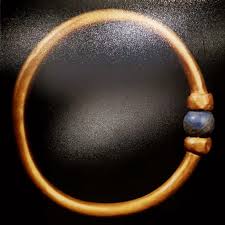Authorities in Egypt have intensified efforts to locate a priceless 3,000-year-old bracelet that recently went missing from the Egyptian Museum in Cairo, one of the world’s most renowned repositories of ancient treasures. The rare artefact, crafted in solid gold and adorned with spherical lapis lazuli beads, is believed to date back to the reign of King Amenemope of the 21st Dynasty, who ruled between 993 and 984 BC. Its sudden disappearance has raised alarm within Egypt’s Ministry of Antiquities, which confirmed that the bracelet vanished from the museum’s restoration laboratory under circumstances that remain under investigation.
The ministry announced that immediate measures had been taken once the loss was detected, with the case swiftly referred to law enforcement authorities. As part of the search, an official image of the missing bracelet has been widely circulated to all airports, seaports, and land border crossings across Egypt to prevent any attempt at smuggling the treasure out of the country. In addition, a specialist committee has been established to conduct a thorough review and inventory of all artefacts housed within the restoration laboratory, a move aimed at ensuring that no further objects are unaccounted for.
Egyptian officials acknowledged that they had delayed announcing the bracelet’s disappearance in order to create what they described as a secure environment for investigations. However, they have yet to clarify exactly when the piece was last seen. Local media, including the widely read Al-Misri al-Yawm newspaper, reported that the missing artefact was discovered only in recent days, as curators and staff were preparing to ship dozens of objects to Rome for an upcoming exhibition scheduled to open next month.

The incident has attracted significant public attention, not only because of the bracelet’s exceptional age and craftsmanship but also because of its association with Pharaoh Amenemope, whose legacy endures through a number of funerary artefacts. His gilded wooden funerary mask, a striking relic of the 21st Dynasty, remains on display at the Egyptian Museum, further underscoring the significance of the missing bracelet within the broader context of Egypt’s ancient history.
The Egyptian Museum in Cairo, established in 1902, holds the distinction of being the oldest archaeological museum in the Middle East. It houses more than 170,000 artefacts spanning Egypt’s long and illustrious past, including the treasures of dynasties that defined the ancient world. The disappearance of such an important piece has therefore heightened concerns about security and preservation standards at a time when Egypt is preparing for one of its most anticipated cultural milestones in decades.
In just a few weeks, the Grand Egyptian Museum in Giza is scheduled to open its doors to the public, showcasing the full collection of King Tutankhamun’s treasures for the first time in history. The timing of the bracelet’s disappearance has cast an unfortunate shadow over the preparations, with critics warning that theft or mishandling of such priceless antiquities could damage Egypt’s reputation as a global custodian of ancient heritage. For the Egyptian government, recovering the missing bracelet has now become not just an archaeological priority but also a matter of national pride and international credibility.
As the investigation continues, experts stress the bracelet’s immense historical and cultural value. Beyond its material worth as a piece of ancient jewellery made from gold and lapis lazuli, the artefact offers rare insights into the artistry, craftsmanship, and symbolic traditions of the 21st Dynasty. Its loss represents not only the disappearance of a physical object but also a gap in the chain of Egypt’s history that the world has a vested interest in preserving. Authorities remain optimistic that swift coordination with law enforcement and border agencies will help locate the bracelet, ensuring its return to the Egyptian Museum where it rightfully belongs.














Leave a comment